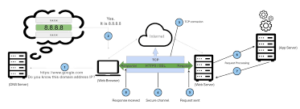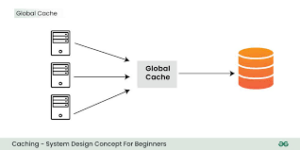Imagine a web server as a dynamic duo of software and hardware that works tirelessly behind the scenes, utilising protocols like HTTP (Hypertext Transfer Protocol) to cater to requests from users surfing the World Wide Web. Its primary role is akin to that of a diligent librarian, meticulously storing, processing, and delivering webpages so that anyone can access the content they seek.
Discover How Web Servers Work
But this versatile server doesn’t stop at just handling HTTP; it also embraces other protocols such as SMTP (Simple Mail Transfer Protocol) for email communications and FTP (File Transfer Protocol) for transferring and storing files. The physical components of the web server are linked to the vast internet, facilitating seamless data exchanges with countless other devices. Meanwhile, the software aspect governs how users interact with the files hosted on it.

This entire operation exemplifies the client-server model—a foundational concept in computing in which one party requests information while another provides it. Every computer that hosts a website must be equipped with web server software to function correctly. In essence, web servers play a crucial role in web hosting, managing all the data necessary for websites and online applications to thrive in our digital landscape.
How Web Servers Keep You Connected Daily
Picture a web server as a dynamic team of hardware and software, tirelessly working behind the curtain to fulfil requests from users navigating the vast expanse of the internet. Its primary function resembles that of a dedicated librarian, carefully archiving, processing, and delivering webpages so that anyone can find the information they desire. Yet this adaptable server goes beyond merely managing HTTP (Hypertext Transfer Protocol); it also supports various other protocols like SMTP (Simple Mail Transfer Protocol) for handling emails and FTP (File Transfer Protocol) for transferring and managing files. The physical elements of the web server connect to the immense network of the internet, enabling smooth data exchanges with countless devices. At the same time, its software dictates how users engage with the files it hosts. This entire process illustrates the client-server model—a fundamental principle in computing where one entity requests information while another supplies it. Every computer hosting a website must have web server software installed to operate effectively. Ultimately, web servers are essential in web hosting, overseeing all necessary data for websites and online applications to flourish in our digital world.

Dynamic versus Static Web Servers
When it comes to enhancing the security of web servers, there are numerous strategies that individuals can adopt to create a more secure environment. For instance, implementing a reverse proxy can be an effective way to shield internal servers from direct exposure, serving as a go-between for incoming traffic. Additionally, restricting access is crucial—this might involve limiting the web host’s reach to critical infrastructure or employing Secure Socket Shell (SSH) for secure communications.

Keeping web servers updated and patched is essential in protecting them against potential vulnerabilities. Regular network monitoring helps detect any unauthorised activities that could indicate security breaches. Moreover, utilising firewalls can play a significant role in overseeing HTTP traffic while incorporating Secure Sockets Layer (SSL) technology ensures that sensitive data remains protected during transmission. By embracing these practices, individuals can significantly bolster their web server’s defences and foster a safer online experience.
Web Server Software
Several prominent options stand out in today’s market for web server software. Among them is the Apache HTTP Server, crafted by the Apache Software Foundation. This versatile and freely available web server supports a variety of operating systems, including Windows, Mac OS X, Unix, Linux, and Solaris, all under the Apache license.

Then there’s Microsoft Internet Information Services (IIS), a robust solution developed by Microsoft specifically for its platforms. While it remains proprietary and not open-source, its powerful features enjoy widespread adoption.
Another notable contender is Nginx—pronounced engine X—which has gained popularity among administrators for its efficient resource management and effortless scaling. Its event-driven architecture allows it to manage numerous simultaneous connections effectively. Additionally, Nginx can function as both a proxy server and a load balancer.
Lighttpd offers another option; this accessible web server comes bundled with the FreeBSD operating system. Renowned for its speed and security while consuming minimal CPU resources, Lighttpd caters to those seeking efficiency.
The Sun Java System Web Server from Sun Microsystems is also noteworthy. This accessible web server operates seamlessly on Windows, Linux, and Unix platforms and is particularly adept at supporting medium to large-scale websites.

When discussing leading web servers today, names like Apache, Microsoft’s IIS, and Nginx are commonly mentioned alongside others such as Novell’s NetWare server, Google Web Server (GWS), and IBM’s Domino servers.
Choosing the correct web server involves several considerations: compatibility with existing operating systems and other servers, support for server-side programming, security features; as well as integrated tools for publishing sites or optimising search engine performance. Each web server may come with various configurations that establish default settings tailored to specific needs. Achieving high-performance levels—characterised by high throughput and low latency—is essential for optimal operation.
Incoming traffic from external sources. Such measures contribute significantly to creating a more secure online environment.
Security of Web Servers
Ensuring the security of web servers is crucial for a safe online experience, and there are numerous strategies that individuals can implement to enhance this security. For instance, employing a reverse proxy can effectively conceal an internal server while serving as a traffic intermediary. Additionally, restricting access is vital—this might involve limiting the web host’s reach to critical infrastructure or utilising Secure Socket Shell (SSH) for secure connections. Regularly updating and patching web servers is another essential practice, as it helps protect against potential vulnerabilities. Furthermore, vigilant network monitoring is necessary to detect any unauthorised activities that could compromise security. Lastly, implementing firewalls alongside Secure Sockets Layer (SSL) protocols can provide robust protection; firewalls monitor HTTP traffic effectively, while SSL ensures that data remains secure during transmission.

How Maxthon Browser Optimised Servers
1. Utilize Cloud Acceleration: Maxthon browser employs advanced cloud technology to accelerate web performance. By routing requests through its global cloud servers, it reduces load times and enhances browsing speed.
2. Data Compression Techniques: The browser compresses data before sending it to users. This minimises the amount of data transferred, making web pages load faster while conserving bandwidth.

3. Resource Management: Maxthon effectively manages server resources by prioritising essential elements during page loading. This ensures that critical components appear quickly for a smoother user experience.
4. Cache Optimization: It uses intelligent caching methods to store frequently accessed data locally on the user’s device, reducing the need for repeated server requests and further speeding up browsing.
5. Adaptive Content Delivery: The browser adapts content delivery based on network conditions, automatically switching between standard and optimised modes to enhance performance when necessary.
6. Support for Multiple Protocols: Maxthon supports various protocols (like HTTP/2), enabling faster communication between the browser and servers for a more efficient loading process.
7. User-Driven Settings: Users can customise their settings in Maxthon to optimise how the browser interacts with web servers according to individual preferences or connection types.
8. Regular Updates: Continuous updates ensure that the browser is equipped with the latest optimisation features, security patches, and enhancements related to server performance.
9. Integrated Ad Blocker: By incorporating an ad blocker, Maxthon reduces unnecessary data loading from advertisements, resulting in quicker access to content-rich sites without distractions.
By combining these strategies, Maxthon successfully optimises server interactions, delivering a fast and efficient browsing experience for its users.

